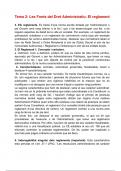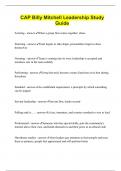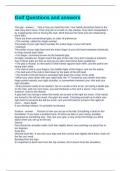RIJKSUNIVERSITEIT GRONINGEN – MASTER FINANCE 2022-2023
WEEK 1: INTRODUCTION: BEYOND MODIGLIANI-MILLER
Classical corporate finance
In perfect capital markets:
1. All projects that have a positive NPV (Net Present Value) will be financed
2. It is irrelevant how projects/firms are financed
a. Modigliani and Miller (1958): value of the firm is not affected by capital structure (debt/equity) but
only by the free cash flows generated by the assets.
In the real world there are imperfections:
• Taxes → debt gets preferred treatment by tax office
o While total cash flows are not affected by capital structure, the share of cash flows to tax is lower
(when there is debt).
• Bankruptcy costs
o Real costs of reorganizing etc.
o Informational costs (loss of confidence, negotiation costs)
• Agency costs → managers and funders have different objectives
o Capital structure helps to incentivize managers
o Balance between debt (effort incentives) and equity financing (risk taking incentives)
• Hidden information
o Pecking order of financing (Myers and Majluf) → firms prefer to attract finances first from sources
that are least sensitive to the hidden value of the firm
▪ E.g., internal financing, debt
o Signal that your company has high value
▪ E.g., buy your own stocks
Common theme: Information
There are information asymmetries between those who provide funding and those who manage the firm.
Course objective: exploring the consequences of these information problems in a structured way. Describe the
firm through the lens of a principal-agent problem.
Principal-agent problem:
Investors Delegate managerial decision
Manager
making
(Principal) (Agent)
These have conflicting interests! + manager has better information
Information asymmetry
• Moral hazard (hidden action): managers take action that benefit themselves, but not the owners.
o E.g., pet projects, perks, hiring family, empire building, self-dealing.
o So there is an effort choice: work 80 hr weeks versus spend time on golf clinics for instance.
• Adverse selection (hidden information): manager has more information and knows if an investment is
really valuable or whether they like it more for some other (personal) reason.
o Creative accounting: accounting things that did not occur or slightly change things: hide costs and
inflate revenues.
,Corporate Finance/Governance
How can we design financing contracts that assure the funders that their managers will:
1. Act in the funders’ interest
2. Tell the truth
That is, mitigate the principal agent problems?
Tools:
• Executive Compensation/Remuneration contracts: what financial incentives can you put into the contract
to align interests?
• Monitoring: reduce the manager’s ability to deviate.
o External party (board member, bank, etc.) is taking closer look at what the firm is doing.
• Control: who has the right to decide what?
o E.g., who decides on new investment?
o Venture capitalists: under what conditions is management replaced?
Fixed Investment Model
The fixed investment model is a simple model that helps us determine how to eliminate moral hazard.
An entrepreneur needs outside financing from an investor to execute a risky project. So, they have to write a
contract on how to split the proceeds of the investment. The entrepreneur may mismanage the project by taking
a private benefit which lowers the probability of project success, for instance investing the money in a second
project from which the investor gets no return.
There is a project: The entrepreneur: The investor:
• With payoff 𝑹 or 𝟎 • Has assets 𝐴 • Provides the remaining 𝐼 − 𝐴
• Which requires an investment 𝑰 • Crucial: 𝐴 < 𝐼
Project pay-off
• The project produces 𝑅 with probability 𝑝
• Crucial: 𝑝 depends on the unobservable efforts the entrepreneur puts in the project:
o In case of effort, the probability of success is high: 𝑝𝐻
o In case of no effort, the probability of success is low: 𝑝𝐿 and the entrepreneur receives a private
benefit 𝐵
o Difference is: ∆𝑝 ≡ 𝑝𝐻 − 𝑝𝐿
• If the entrepreneur exerts effort the payoff is positive: 𝑝𝐻 𝑅 − 𝐼 > 0
o In perfect capital markets such projects should always receive funding
• If the entrepreneur does not exert effort the payoff is negative: 𝑝𝐿 𝑅 − 𝐼 + 𝐵 < 0
o If no effort, the project should not receive funds!
Success (high probability)
Failure (low probability)
Success (low probability)
Failure (high probability)
,The funding contract
• Funder supplies 𝐼 − 𝐴, entrepreneur supplies 𝐴.
• In case of success, 𝑅 is split between investor and entrepreneur
o 𝑅𝑙 goes to the investor (lender)
o 𝑅𝑏 goes to the entrepreneur (borrower)
➔ 𝑅 = 𝑅𝑙 + 𝑅𝑏
• In case of failure, there is no payoff
o The investor loses 𝐼 − 𝐴
o The entrepreneur loses 𝐴
▪ Limited liability prevents the investor from claiming the remainder, 𝐼 − 𝐴 , from the
entrepreneur.
Can we design a funding contract (𝑅𝑏 , 𝑅𝑙 ), such that the entrepreneur’s objectives are aligned with the investor’s
objectives? That is, one that gives the entrepreneur an incentive to put in effort, and makes it worthwhile for
the investor to invest his money.
𝑝𝐻 (𝑝𝐿 ) 𝑅 = 𝑅𝑏 + 𝑅𝑙 (+𝐵) because low effort
𝐼
1 − 𝑝𝐻
0 (+𝐵)
(1 − 𝑝𝐿 )
Entrepreneur’s incentives
Incentive Compatibility Constraint (ICC): entrepreneur acts to maximize private payoff, so we have to make the
contract such that the entrepreneur would prefer putting in the effort (or at least is indifferent between effort
𝐵 𝐵
and no effort): ⏟ 𝑝𝐿 𝑅𝑏 + 𝐵 → (𝑝𝐻 − 𝑝𝐿 )𝑅𝑏 ≥ 𝐵 →
𝑝𝐻 𝑅𝑏 ≥ ⏟ 𝑅𝑏 ≥ (= )
𝑝𝐻 −𝑝𝐿 ∆𝑝
effort no effort
Investor’s choice
Participation Constraint (PC): investor acts to maximize private payoff, so the investor must be sure or at least
have the expectation that he will get paid (what he put in): 𝑝𝐻 𝑅𝑙 ≥ 𝐼 − 𝐴
Can we find payments, 𝑅𝑙 + 𝑅𝑏 = 𝑅, such that both incentive compatibility and participation are ensured?
Satisfying both conditions
𝐵
• 𝐼𝐶𝑏 : ∆𝑝𝑅𝑏 ≥ 𝐵 → 𝑅𝑏 ≥
∆𝑝
𝐵
• 𝑅𝑙 = 𝑅 − 𝑅𝑏 , so maximum payment to the lender is: 𝑅𝑙𝑚𝑎𝑥 = 𝑅 −
∆𝑝
• Pledgeable income: the maximum income promised to outside investors in expectation
𝐵
𝑃 = 𝑝𝐻 𝑅𝑙𝑚𝑎𝑥 = 𝑝𝐻 (𝑅 − )
∆𝑝
• 𝑃𝐶𝑙 : 𝑝𝐻 𝑅𝑙 ≥ 𝐼 − 𝐴
𝐵
• Financial constraint: Since we can maximally promise lenders 𝑃 = 𝑝𝐻 (𝑅 − ), financing is only possible
∆𝑝
𝐵 𝐵 𝐵
if: 𝑝𝐻 (𝑅 − ) ≥ 𝐼 − 𝐴 → 𝐴 ≥ 𝐼 − 𝑝𝐻 (𝑅 − ) = 𝑝𝐻 − (𝑝𝐻 𝑅 − 𝐼) = 𝐴̅
∆𝑝 ∆𝑝 ∆𝑝
o We can only find 𝑅𝑏 , 𝑅𝑙 , provided that the amount of assets the entrepreneur puts into the project
𝐵
is bigger than some minimum value if 𝐴 ≥ 𝐴̅ = 𝑝𝐻 − (𝑝𝐻 𝑅 − 𝐼)
∆𝑝
PC combined with ICC allows us to derive the minimum amount of assets that the entrepreneur has to put into
𝐵
the project: 𝐴̅ = 𝑝𝐻 − (𝑝𝐻 𝑅 − 𝐼)
∆𝑝
,The contract
• If 𝐴 < 𝐴̅ no investment is provided, even though the project has a positive NPV! (credit rationing)
• If 𝐴 ≥ 𝐴̅ investment is provided:
o Investor invests 𝐼 − 𝐴 for a return 𝑝𝐻 𝑅𝑙
▪ Competition between investors assures → 𝑝𝐻 𝑅𝑙 = 𝐼 − 𝐴
𝐼−𝐴
o Entrepreneur gets the rest: 𝑅𝑏 = 𝑅 − 𝑅𝑙 = 𝑅 −
𝑝𝐻
Main question: Can we design a financing scheme such that the entrepreneur’s objectives are aligned with the
investor’s objectives? → Answer: Not always, only possible if entrepreneur has sufficient own assets 𝐴.
Consequences of Moral Hazard
Credit rationing to low net-worth individuals: positive net present value projects are not executed.
Possible solutions:
• Diversification & sequential projects
• Monitoring
• Use control rights to influence incentives
WEEK 2: DEBT OVERHANG, DIVERSIFICATION AND SEQUENTIAL PROJECT S
Agency costs: Moral hazard leads to inefficiencies
Credit rationing: projects with positive net present value are not financed if the entrepreneur has low net-worth
Fixed investment model: Work horse model of theoretical corporate finance
(Recap) fixed investment model
• Entrepreneur seeks outside financing from an investor for a risky project
• The success of the project depends on the effort of the entrepreneur
• If the entrepreneur does not put in effort (s)he receives a private benefit but the probability of success
declines
General approach to crack the model
1. What is the question?
o Entrepreneur has net-worth 𝐴 < 𝐼, remaining 𝐼 − 𝐴 is attracted from a competitive investor
o Investor only observes outcome (𝑅 or 0)
o Find 𝑅𝑏 , 𝑅𝑙 (naturally 𝑅𝑏 + 𝑅𝑙 = 𝑅) that:
▪ Maximizes entrepreneur’s utility (competitive market)
▪ Has non-negative payout 𝑅𝑏 (limited liability)
▪ Is incentive compatible for entrepreneur
▪ Satisfies participation constraint for investor
2. Analyse constraints: when does the entrepreneur put in effort? → incentive compatibility constraint
o Entrepreneur acts to maximize private payoff:
𝐵
▪ Puts in effort if: 𝑝𝐻 𝑅𝑏 ≥ 𝑝𝐿 𝑅𝑏 + 𝐵 → 𝑅𝑏 ≥
∆𝑝
𝐵
o Entrepreneur can only offer to investor at most 𝑝𝐻 (𝑅 − 𝑅𝑏𝑚𝑖𝑛 ) = 𝑝𝐻 (𝑅 − )
∆𝑝
3. Analyse constraints: when is the lender willing to invest? → participation constraint
o The investor provides financing if the expected pledgeable income is higher than the required
𝐵
financing needs: 𝑝𝐻 (𝑅 − )≥𝐼−𝐴
∆𝑝
o If the PC holds, the investor provides financing and receives 𝑝𝐻 𝑅𝑙 = 𝐼 − 𝐴 due to perfect
competition between investors.
4. Find optimal contract + interpret the outcome
, o The PC implies a minimum amount of assets that the entrepreneur has to put into the project: 𝐴̅ =
𝐵
𝐼 − 𝑝𝐻 (𝑅 − )
∆𝑝
o If 𝐴̅ > 𝐴 > 0 no investment is provided, even though the project has positive NPV and the
individual has positive net worth!
▪ Credit rationing to low net-worth individuals
▪ “lend to the rich”
o If project is financed:
▪ Lender’s PC is binding (competition): 𝑝𝐻 𝑅𝑙 = 𝐼 − 𝐴
o Borrower gets 𝑈𝑏 = 𝑝𝐻 𝑅𝑏 + (1 − 𝑝𝐻 )0 = 𝑝𝐻 (𝑅 − 𝑅𝑙 ) = 𝑝𝐻 𝑅 − 𝐼 + 𝐴
▪ Started out with 𝐴
▪ Net benefit to borrower: full surplus (NPV)
Pre-existing debt: Debt Overhang (Agency costs of bankruptcy)
Debt overhang: inability to finance profitable new investment as a result of (too) large debt burden.
• The entrepreneur has no cash → 𝐴 = 0
• The entrepreneur has a profitable and incentive compatible project (𝐴̅ < 0)
• There is pre-existing debt 𝐷
If the project is not carried out, firm is terminated:
• No recovery for original debt holders
• No benefit for agent
𝐵
We assume that if all the required payments (that is, to the entrepreneur so he will put in effort; and 𝐷 to the
∆𝑝
original debt holders that if the project is a success, the debt holders will be completely paid off) are made, not
enough money remains to make sure that new outside investors will break even:
𝐵
• So, in this case: 𝑝𝐻 (𝑅 − − 𝐷) < 𝐼
∆𝑝
• New investors will not go on board
If the initial investor has additional funds:
• Forgive debt and invest 𝐼 into the new project
𝐵
• Promise the entrepreneur to assure effort
∆𝑝
𝐵
• Expected return for this investor is then: 𝑝𝐻 (𝑅 − )−𝐼 > 0
∆𝑝
𝐵
• Entrepreneur agrees: 𝑈𝑏 = 𝑝𝐻 >0
∆𝑝
Problem if initial investors cannot fund the new project:
• Initial investors get 0 without project
• New investors cannot break even
➔ Inefficient!!!
• Solution: renegotiation with initial investors → give up part of their claim 𝐷 to allow the project to be
financed by others.
𝐵
Renegotiation is to reduce claim 𝐷 to 𝑑, such that new investors will break even: 𝑝𝐻 (𝑅 − − 𝑑) = 𝐼
∆𝑝
• Old investors get 0 < 𝑝𝐻 𝑑 < 𝑝𝐻 𝐷
𝐵
• Entrepreneur gets 𝑝𝐻
∆𝑝
➔ Efficiency restored as long as renegotiation succeeds
,Boosting pledgeable income: Multiple projects
• Only projects with pledgeable income sufficient to cover (outside) investment can be financed:
𝐵
𝑝𝐻 (𝑅 − )≥𝐼−𝐴
∆𝑝
• Inefficiency: some positive NPV projects not undertaken
• Howe can we increase pledgeable income?
o Diversification
o Sequential projects/long-term relationship
Diversification
We assume that:
• These projects are independent
• Entrepreneur has assets 2𝐴
We want to compare diversification with a benchmark: separate financing → can finance both projects
𝐵
separately if 𝐴 ≥ 𝐴̅ or 𝑝𝐻 (𝑅 − )≥𝐼−𝐴
∆𝑝
In the case that the projects cannot be financed separately (there is only enough money to finance one of them),
we can still find a way to get both projects financed.
Joint project financing: put the two projects together and ask for financing for both of them together
• Reason to do this is cross-pledging → the income of one project is used as collateral for the other project
• Reward scheme for the entrepreneur:
o 𝑅0 : all projects fail
o 𝑅1 : one project succeeds
o 𝑅2 : both projects succeed
• Assume full cross-pledging so that:
o 𝑅0 = 𝑅1 = 0
o 𝑅2 > 0
➔ Maximize incentives: work hard on both projects to succeed payoff
Now we have two incentive compatibility conditions that we need to satisfy.
𝐈𝐂𝟏 : prefer to put effort in both projects instead of none
• 𝑝𝐻2 𝑅2 ≥ 𝑝𝐿2 𝑅2 + 2𝐵 (𝑝𝐻2 − 𝑝𝐿2 ) = (𝑝𝐻 − 𝑝𝐿 )(𝑝𝐻 + 𝑝𝐿 )
(𝑝𝐻2 − 𝑝𝐿2 )𝑅2 ≥ 2𝐵
2𝐵 2 𝐵 2 𝐵 2 𝐵
𝑅2 ≥ 2 −𝑝 2 ) = (𝑝 = 𝑅2 =
(𝑝𝐻 𝐿 𝐻 +𝑝𝐿 ) (𝑝𝐻 −𝑝𝐿 ) 𝑝𝐻 +𝑝𝐿 ∆𝑝 𝑝𝐻 +𝑝𝐿 ∆𝑝
𝐈𝐂𝟐 : prefer to put effort in both projects instead of one
• 𝑝𝐻2 𝑅2 ≥ 𝑝𝐻 𝑝𝐿 𝑅2 + 𝐵
𝑝𝐻 (𝑝𝐻 − 𝑝𝐿 )𝑅2 ≥ 𝐵
1 𝐵 1 𝐵 1 𝐵
𝑅2 ≥ = 𝑅2 =
𝑝𝐻 𝑝𝐻 −𝑝𝐿 𝑝𝐻 ∆𝑝 𝑝𝐻 ∆𝑝
, IC1 is more difficult and hence the stronger condition → if IC1 holds, IC2 will hold for sure as well.
𝑝𝐻 +𝑝𝐿
• is the average of the p-values which is lower than 𝑝𝐻 (because 𝑝𝐻 > 𝑝𝐿 )
2
2 1
• So = (divide both the nominator and denominator by 2)
𝑝𝐻 +𝑝𝐿 average 𝑝
2 𝐵 1 𝐵
• Thus, > , so if 𝑅2 holds for IC1 , where 𝑅 is larger, IC2 will also hold.
𝑝𝐻 +𝑝𝐿 ∆𝑝 𝑝𝐻 ∆𝑝
2 𝐵
The minimum payoff to assure effort by the entrepreneur: 𝑅2𝑚𝑖𝑛 =
𝑝𝐻 +𝑝𝐿 ∆𝑝
2
2𝑝𝐻 𝐵
So how much we need to (promise to) pay in expectation to the entrepreneur: 𝑝𝐻2 𝑅2𝑚𝑖𝑛 = (𝑝
𝐻 +𝑝𝐿 )∆𝑝
• Comparison agency rents joint and separate financing:
𝑝𝐻 𝑝𝐻 𝐵
o Joint: 2 (𝑝
𝐻 +𝑝𝐿 ) ∆𝑝
𝑝𝐻 𝐵
o Separate: 2
∆𝑝
𝑝𝐻
▪ Since (𝑝 < 1, the minimum promised payoff to the entrepreneur decreases when we
𝐻 +𝑝𝐿 )
finance the projects together.
The total expected income from the projects is: 2𝑝𝐻 𝑅
2
2𝑝𝐻 𝐵
So, the expected pledgeable income to the investor: 2𝑝𝐻 𝑅 − (𝑝 =𝑃
𝐻 +𝑝𝐿 )∆𝑝
𝐏𝐂𝒍 : the investor will only provide financing if the pledgeable income is sufficient to break even:
𝑝𝐻 𝑝𝐻 𝐵
• 2 (𝑝𝐻 𝑅 − (𝑝 ) ≥ 2𝐼 − 2𝐴
𝐻 +𝑝𝐿 ) ∆𝑝
So the minimum amount of assets that the entrepreneur has to put into the project:
𝑝 𝐵
• 𝐴̿ = 𝐼 − 𝑝𝐻 (𝑅 − (𝑝 𝐻 )
𝐻 +𝑝𝐿 ) ∆𝑝
Mathematics to achieve this:
𝑝𝐻 𝑝𝐻 𝐵 𝑝𝐻 𝑝𝐻 𝐵 𝑝𝐻 𝐵
2 (𝑝𝐻 𝑅 − (𝑝 ) ≥ 2(𝐼 − 𝐴) → 𝑝𝐻 𝑅 − (𝑝 ≥𝐼−𝐴 → 𝑝𝐻 (𝑅 − )≥ 𝐼−𝐴 →
𝐻 +𝑝𝐿 ) ∆𝑝 𝐻 +𝑝𝐿 ) ∆𝑝 𝑝𝐻 +𝑝𝐿 ∆𝑝
𝑝𝐻 𝐵 𝑝𝐻 𝐵
𝑝𝐻 (𝑅 − )+𝐴 ≥ 𝐼 → 𝐴 ≥ 𝐼 − 𝑝𝐻 (𝑅 − )
𝑝𝐻 +𝑝𝐿 ∆𝑝 𝑝𝐻 +𝑝𝐿 ∆𝑝
• We want to compare the minimum amount of assets to the benchmark of separate financing:
𝑝 𝐵
o Joint: 𝐴̿ = 𝐼 − 𝑝𝐻 (𝑅 − (𝑝 𝐻 )
𝐻 +𝑝𝐿 ) ∆𝑝
𝐵
o Separate: 𝐴̅ = 𝐼 − 𝑝𝐻 (𝑅 − )
∆𝑝
𝑝𝐻
▪ Since (𝑝 < 1, 𝐴̿ < 𝐴̅
𝐻 +𝑝𝐿 )
➔ The amount of assets that the entrepreneur needs in order to fund both projects as a joint
operation is lower than the amount of assets he needs to fund each project separately.
Diversification creates value by decreasing the minimum amount of assets held by the entrepreneur to assure
financing by the investor. Crucial assumptions:
• Projects are uncorrelated
• Entrepreneur can handle both projects equally well
o Within core competency (no empire building)
o No limited attention
Sequential Projects
We assume:
• No assets: 𝐴 = 0
𝐵
• Insufficient pledgeable capital, 𝑝𝐻 (𝑅 − ) < 𝐼, so not financed separately.
∆𝑝










